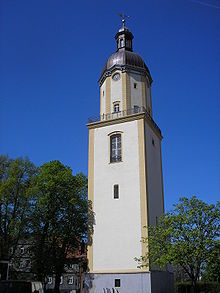Michaeliskirche (Ohrdruf)
The Michaeliskirche , the beginnings of which go back to the 8th century, was the Protestant parish church of the town of Ohrdruf in Thuringia until it was destroyed . Today only the renewed church tower remains, the nave fell victim to an American air raid in February 1945.
history
The beginnings of Michaeliskirche go back to the time of the missionary bishop Bonifatius around 724/725 AD. From these beginnings, a small chapel, several successor buildings were built after destruction and city fires.
In the previous building, a Gothic hall church that fell victim to a great fire in 1753, Johann Sebastian Bach still performed as a carol singer between 1695 and 1700 with his eldest brother Johann Christoph Bach , who lived in Ohrdruf , and had learned to play the organ. The fire, which reduced 262 houses to rubble in Ohrdruf and made 1247 residents homeless, also destroyed the Bonifatius chapel belonging to the church, which was built around 725 as a monastery chapel by Bonifatius. Only the crypt of the Counts of Gleichen from 1616 and the lower part of the tower remain of the church.
The Gotha master builder Johann David Weidner (1721–1784) was chosen as the architect for the new building, who created his main work with this church. Weidner was influenced in his professional development by the Thuringian baroque master builder Gottfried Heinrich Krohne (1703–1756), who had received the order for a representative court church planned on the market square of Eisenach , but which was not executed. Michaelis Church was built from 1754 to 1760 in the northeastern part of the old town on a small hill above the left bank of the Ohra river . Opposite the church is Ehrenstein Castle from the years 1550 to 1590. On September 19, 1754 the foundation stone for the nave was laid. The floor plan shows a similarity to that of the Waltershausen town church . It was a transept church with a central building character through segment-arched exedra on the north, east and south sides and an elliptical floor plan. In the west, inclusion of the medieval tower between stairways, it was raised by an octagon with a baroque dome. The nave had two-part windows, portals with richly cranked cornices and rococo cartouches above the keystones, above them pilasters. The church had a hipped gable roof. For the bell casting in 1755, master bell founder Nicolaus Jonas Sorber was responsible.
The new building burned down during the second major fire in Ohrdruf on the night of January 5th to 6th, 1808. The tower and the walls around the nave were preserved. The church was renovated from 1818 to June 29, 1823, it received a different roof shape and was generally simpler.
On February 6, 1945 the church fell victim to an American air raid . Three high explosive bombs hit the building. Part of the walls surrounding the nave and the lower part of the tower remained. The nave was completely demolished. To this day, only the square tower made of quarry stone from the 15th century remains of the Michaeliskirche. It was the only part of the church to survive the great city fires of 1753 and 1808, as well as the bombing raid of 1945. Until 1951, the remains of the tower were secured, covered with a simple concrete tent roof and thus survived the years until the fall of the Wall . Since 1999 the restored church tower with its upper part has been a landmark of the city that can be seen from afar and shines in its old splendor.
Today the Michaelisturm houses a small chapel and an exhibition on its history. As part of the restoration, additional rooms were created in the Michaelisturm, which are used for a variety of events. It is possible to visit the tower as part of a guided tour.
The foundation walls of the destroyed nave are traced in the stone pavement. There is also a small memorial in memory of the place where Bach learned to play the organ. It carries Beethoven's sentence: “It should not be called Bach, but Meer”.
The function of the Protestant parish church for the whole of Ohrdruf was taken over by the Trinity Church from February 1945 , which had previously been the church for the suburbs and garrison church.
Individual evidence
- ↑ Handbook of the historical book inventory in Germany, Austria and Europe (Fabian handbook): St. Michaelis Church (Ohrdruf). Retrieved April 15, 2019 .
- ↑ Rudolf Zießler in: Fates of German Architectural Monuments in the Second World War. [Ed.]: Götz Eckardt, Henschelverlag, Berlin 1978. Volume 2, p. 496.
- Hartmut Ellrich et al .: Ohrdruf «St. Michaelis » . In: Between Hörsel and Wilder Gera. The churches of the superintendent in Waltershausen-Ohrdruf . Wartburg-Verlag, Weimar 2005, ISBN 3-86160-167-2 , p. 64 .
Web links
- Homepage of the Evangelical Luth. Kirchgemeinde Ohrdruf with further information
- Tower of the Michaeliskirche on Thuringia.info
Coordinates: 50 ° 49 ′ 42.7 " N , 10 ° 44 ′ 4.9" E




